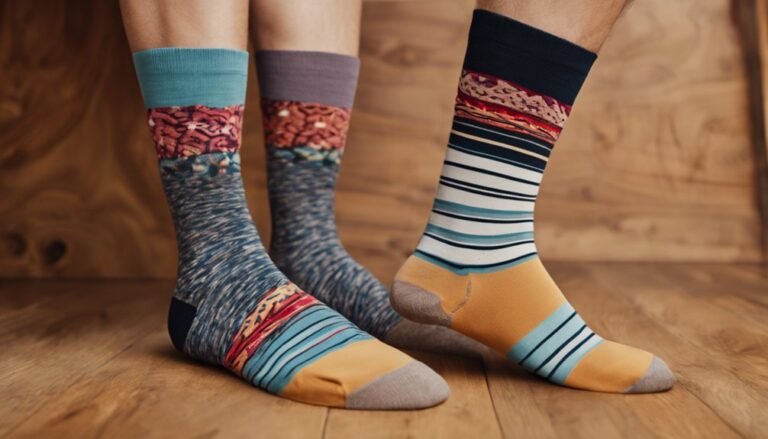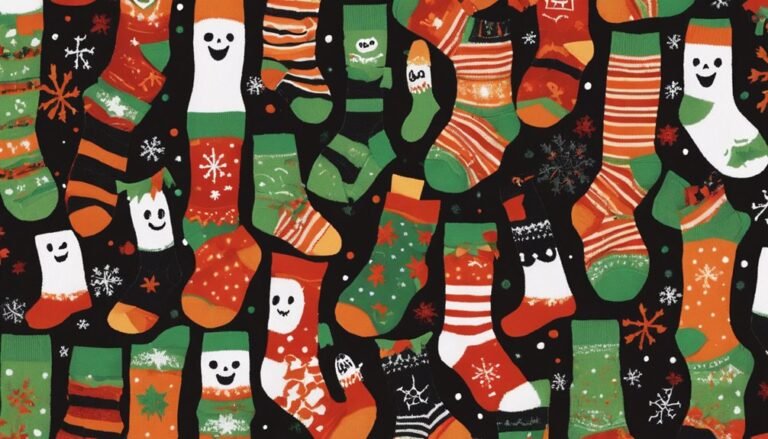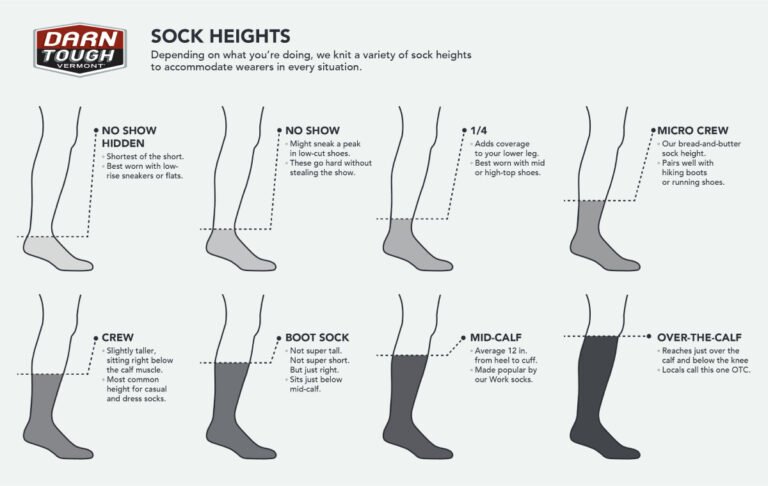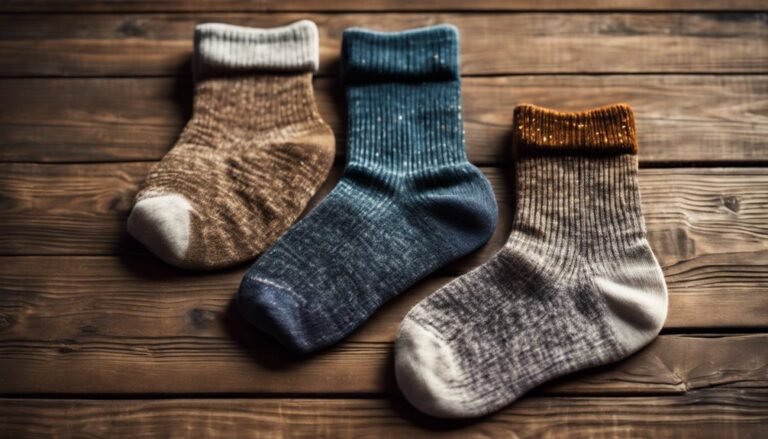Snowboarding Socks vs. Ski Socks: Are They the Same?
Snowboarding socks and ski socks aren't the same—they cater to different needs on the slopes. Snowboarding socks are thicker, offering more cushioning for comfort and impact absorption, while ski socks are thinner for a precise fit and breathability. Each type employs unique materials to wick moisture and regulate temperature, ensuring your feet stay dry and warm. Understanding these differences can enhance your performance, so let's explore what else sets them apart further.
Understanding the Basics: Snowboarding Socks vs. Ski Socks
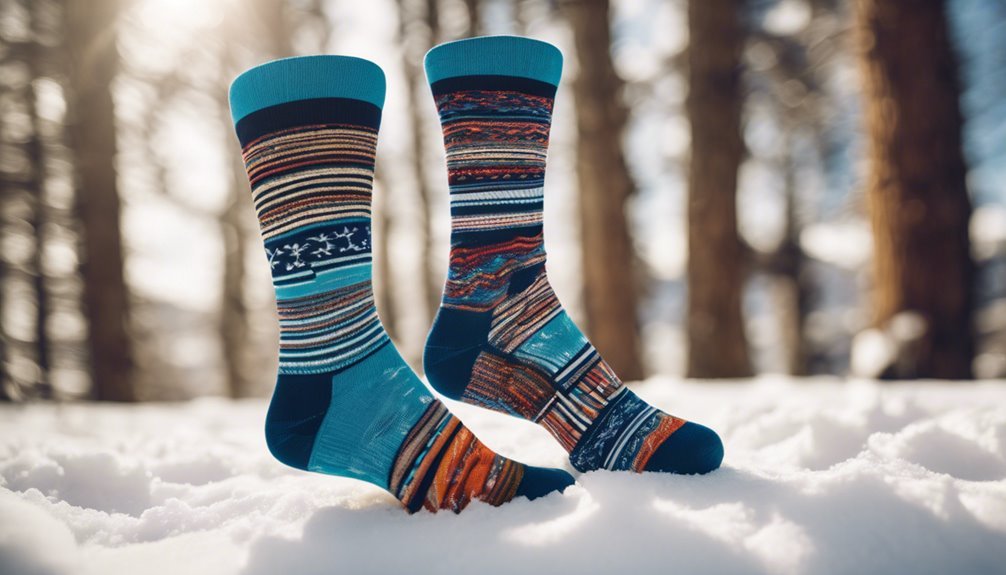
When it comes to hitting the slopes, choosing the right socks can make all the difference in your performance and comfort. Snowboarding socks and ski socks serve distinct purposes, so understanding their differences is key. Generally, snowboarding socks are thicker and provide more cushioning, enhancing comfort during those long rides. In contrast, ski socks tend to be thinner for a more precise fit in your ski boots. Sock length also varies; snowboarding socks often extend higher to prevent chafing, while ski socks might be just below the knee. You'll find a range of color options for both types, allowing you to express your style while staying functional. Prioritize these factors to elevate your experience on the slopes.
Material Matters: What Are They Made Of?
The materials used in snowboarding and ski socks play an essential role in performance and comfort on the slopes. You'll often find that both types utilize advanced performance fabrics designed to wick moisture and regulate temperature. Look for options made from merino wool or synthetic blends; these materials provide excellent insulation while keeping your feet dry. Increasingly, brands are turning to sustainable materials, minimizing environmental impact without sacrificing quality. These eco-friendly fabrics offer durability and breathability, enhancing your ride. When choosing your socks, consider how these materials contribute to your overall experience. A solid pair of socks can mean the difference between a great day on the mountain and an uncomfortable one, so make sure you select wisely!
Thickness and Cushioning: Finding the Right Balance
When choosing snowboarding or ski socks, thickness plays a vital role in your overall comfort and performance. Thicker socks offer more cushioning, which can enhance warmth and reduce pressure points, but they may also compromise fit and responsiveness. Finding the right balance between thickness and cushioning is essential to guarantee you maintain both warmth and control on the slopes.
Sock Thickness Comparison
Although choosing the right thickness of socks may seem trivial, it greatly impacts your comfort and performance on the slopes. Thicker socks often provide enhanced sock warmth, keeping your feet cozy during long rides. However, they can also lead to a tighter fit in your boots, which may restrict blood circulation. On the other hand, thinner socks offer better breathability and flexibility, allowing for a more natural feel. It's crucial to strike the right balance between thickness and fit to avoid discomfort. Additionally, consider sock durability; thicker socks tend to withstand wear better, making them a lasting investment. Your choice ultimately depends on your personal preference and riding style, so experiment until you find the perfect match.
Cushioning Impact on Performance
Finding the right balance between cushioning and thickness in your socks can greatly influence your performance on the slopes. When it comes to cushioning techniques, you want to guarantee they provide support without compromising your agility. Too much cushioning can lead to a loss of sensitivity, which is vital for maneuvering effectively. Conversely, too little cushioning may result in discomfort, detracting from your overall experience. Ideal socks feature targeted cushioning in high-impact areas while maintaining a snug fit that enables freedom of movement. This balance not only enhances comfort but also improves your performance impact, allowing you to ride longer and with greater confidence. Remember, choosing the right sock is as important as selecting the right board or skis for your adventure.
Design Differences: Cut and Style Variations
While both snowboarding and ski socks serve the essential purpose of keeping your feet warm and comfortable on the slopes, their design differences in cut and style cater to the distinct movements and needs of each sport. Snowboarding socks typically feature a taller cut that extends higher up the calf, providing extra warmth and protection against boot chafing during those dynamic movements. In contrast, ski socks often have a more fitted design, with cut variations that promote better stability in a forward-leaning position. Additionally, style preferences vary, as snowboarders may opt for thicker, more cushioned options to absorb impacts, while skiers generally prefer lighter materials for agility. These design choices guarantee that you can fully embrace the freedom of your chosen sport.
Fit and Comfort: How They Conform to Your Feet

When choosing between snowboarding socks and ski socks, the fit and comfort can greatly influence your performance on the slopes. Sock design differences, along with variations in material thickness and cushioning, affect how well each option conforms to your feet. Understanding these factors guarantees you select the right pair for maximum support and comfort during your ride.
Sock Design Differences
Although both snowboarding socks and ski socks are designed for winter sports, their fit and comfort differ considerably due to their intended use. Snowboarding socks often feature a looser fit, allowing freedom of movement and accommodating bulkier boots. Their sock construction focuses on cushioning in key areas, enhancing comfort during falls or extended rides. In contrast, ski socks are typically more form-fitting, providing compression benefits that improve blood circulation and reduce fatigue on the slopes. This design helps you maintain control and responsiveness. Ultimately, choosing the right sock means considering how each design element impacts your performance and enjoyment, ensuring you feel comfortable and secure whether you're carving turns or gliding down the mountain.
Material and Thickness
The choice of material and thickness in snowboarding and ski socks considerably influences how they conform to your feet, impacting overall fit and comfort. High-quality materials not only enhance durability but also provide compression benefits, improving blood flow and reducing fatigue.
| Feature | Snowboarding Socks | Ski Socks |
|---|---|---|
| Material | Merino wool, synthetic | Merino wool, nylon |
| Thickness | Thicker for impact | Thinner for precision |
| Compression Benefits | Yes, reduces swelling | Limited, focuses on fit |
| Longevity Factors | High, due to durability | Moderate, varies by use |
Choosing the right sock thickness and material guarantees you enjoy your time on the slopes while minimizing discomfort and maximizing performance.
Cushioning and Support
Cushioning and support are critical factors in how snowboarding and ski socks fit and conform to your feet, directly affecting your comfort on the slopes. Different cushioning types, such as targeted padding or full-foot cushioning, offer varying levels of shock absorption and comfort. Snowboarding socks often feature extra cushioning in high-impact areas to combat the demands of rugged terrain, while ski socks typically provide a more streamlined fit for precision in tight ski boots. When considering support levels, look for arch support and ankle stability, which can help reduce fatigue during long rides. Ultimately, the right combination of cushioning and support will enhance your performance and keep you feeling free and agile on the mountain.
Moisture-Wicking Properties: Keeping Your Feet Dry
When you hit the slopes, keeping your feet dry is essential for comfort and performance, so choosing the right socks with moisture-wicking properties can make all the difference. Effective moisture control not only enhances your experience but also promotes foot health, reducing the risk of blisters and discomfort.
| Material | Benefits |
|---|---|
| Merino Wool | Naturally moisture-wicking, temperature-regulating |
| Synthetic Blends | Quick-drying, durable |
| Bamboo Fiber | Antimicrobial, soft |
| Coolmax | Excellent moisture management |
| Nylon/Spandex | Stretchy, moisture control |
Impact Absorption: Protecting Your Feet During Falls
While you may be focused on carving turns and enjoying the fresh powder, impact absorption in your socks is essential for protecting your feet during falls. Quality socks with effective padding can enhance your fall recovery by cushioning impacts and reducing strain on your feet. You'll want to take into account:
- Material: Look for high-density foam or gel inserts for ideal shock absorption.
- Fit: A snug fit guarantees the padding stays in place, maximizing foot protection.
- Height: Taller socks can provide additional coverage and support, especially in the lower leg.
Choosing the right socks can greatly improve your comfort and safety on the slopes. With the right impact absorption, you'll be able to focus more on riding and less on avoiding injury.
Temperature Regulation: Staying Warm on the Slopes

When it comes to staying warm on the slopes, understanding the insulation properties of snowboarding and ski socks is essential. You'll want socks that not only provide warmth but also effectively wick moisture away to prevent chilling. Let's explore how these features can impact your comfort and performance on the mountain.
Insulation Properties Comparison
Choosing the right socks for snowboarding or skiing can greatly impact your overall comfort and warmth during a day on the slopes, especially as insulation properties vary between the two. Snowboarding socks generally feature thicker insulation types, providing extra warmth for your toes during long rides. In contrast, ski socks often focus on a more streamlined fit, optimizing performance and reducing bulk.
- Material Composition: Wool blends versus synthetic fibers.
- Thickness Levels: Thicker for warmth, thinner for agility.
- Heat Retention: How effectively each type traps warmth.
When considering insulation types, a performance comparison reveals that snowboarding socks excel in retaining heat, while ski socks balance warmth with flexibility. Choose wisely to maximize your experience on the mountain!
Moisture-Wicking Capabilities
Insulation alone isn't enough to keep you comfortable on the slopes; moisture-wicking capabilities play an essential role in temperature regulation. High-quality snowboarding and ski socks are designed for peak moisture management, effectively pulling sweat away from your skin. This sweat reduction not only keeps your feet dry but also prevents that clammy feeling that can lead to chills. When your feet stay dry, you maintain better warmth and comfort, allowing you to focus on the ride rather than your gear. Look for socks made from synthetic materials or merino wool, which excel in moisture-wicking properties. By choosing the right socks, you can enhance your performance and enjoyment on the mountain, embracing the freedom of the slopes without the distraction of dampness.
Specific Features: Unique Additions for Each Sport
While both snowboarding socks and ski socks serve the essential purpose of keeping your feet warm and comfortable, they feature distinct characteristics tailored to the specific demands of each sport. Snowboarders benefit from socks designed with extra cushioning in high-impact areas, enhancing comfort during jumps and landings. In contrast, ski socks often include breathability features and higher compression levels, providing better ankle support for maintaining control on the slopes.
- Snowboarding socks offer reinforced padding for impact protection.
- Ski socks feature a tighter fit for ideal blood circulation.
- Both types prioritize moisture-wicking to keep your feet dry.
Ultimately, choosing the right sock can elevate your performance and enjoyment, ensuring you feel free to carve down the mountain.
Choosing the Right Pair: Tips for Selecting the Best Socks
When you're gearing up for a day on the slopes, selecting the right socks is essential for both comfort and performance. Start by considering sock length; options like crew or knee-high can provide different levels of warmth and protection. A longer sock typically offers extra cushioning and helps prevent chafing. Next, focus on fabric technology. Look for moisture-wicking materials like merino wool or specialized synthetic blends that keep your feet dry and warm. Additionally, consider socks with targeted support and padding in key areas, like the arch and shin. Finally, don't forget to try them on with your boots to guarantee a snug fit without bunching. With the right choice, you'll enjoy freedom and comfort while conquering the slopes!
Frequently Asked Questions
Can I Use Snowboarding Socks for Skiing and Vice Versa?
You can use snowboarding socks for skiing and vice versa, but consider sock thickness and moisture management. Each sport's demands differ, so guarantee your socks provide comfort and performance for your preferred activity.
How Often Should I Replace My Snowboarding or Ski Socks?
You should replace your snowboarding or ski socks every season, depending on their sock lifespan. Regular sock care, like washing and drying properly, can extend their life, but worn-out socks compromise comfort and performance.
Do Sock Brands Matter When Choosing Ski or Snowboarding Socks?
While some think all socks are alike, sock brands do matter. Quality materials and proper fit enhance warmth and comfort, preventing blisters. Investing in reputable brands guarantees you enjoy your time on the slopes without distractions.
What Are the Best Brands for Snowboarding and Ski Socks?
When choosing the best brands for snowboarding and ski socks, consider those using advanced sock materials and insulation techniques. Brands like Smartwool and Darn Tough deliver comfort, warmth, and durability, enhancing your freedom on the slopes.
Can I Wear Two Pairs of Socks for Extra Warmth?
Imagine your toes wrapped in a cozy embrace, but wearing two pairs of socks can hinder circulation, reducing warmth factors. Instead, focus on sock layering with quality materials for ideal comfort and performance on the slopes.


